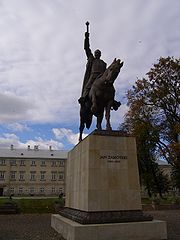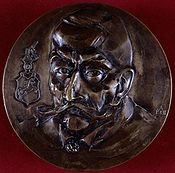
Execution movement
Encyclopedia

Political movement
A political movement is a social movement in the area of politics. A political movement may be organized around a single issue or set of issues, or around a set of shared concerns of a social group...
in the Kingdom of Poland
Kingdom of Poland (1385–1569)
The Kingdom of Poland of the Jagiellons was the Polish state created by the accession of Jogaila , Grand Duke of Lithuania, to the Polish throne in 1386. The Union of Krewo or Krėva Act, united Poland and Lithuania under the rule of a single monarch...
and, later, the Polish-Lithuanian Commonwealth
Polish-Lithuanian Commonwealth
The Polish–Lithuanian Commonwealth was a dualistic state of Poland and Lithuania ruled by a common monarch. It was the largest and one of the most populous countries of 16th- and 17th‑century Europe with some and a multi-ethnic population of 11 million at its peak in the early 17th century...
. It was popular among lesser, middle and even some higher nobility, and it also enjoyed the support of the Polish king. In Polish
Polish language
Polish is a language of the Lechitic subgroup of West Slavic languages, used throughout Poland and by Polish minorities in other countries...
, the movement is variously known as ruch egzekucyjny, egzekucja praw ("execution [enforcement] of the laws"), or egzekucja dóbr ("execution of property"). The movement sought the revendication of public
Public property
Public property is property, which is dedicated to the use of the public. It is a subset of state property. The term may be used either to describe the use to which the property is put, or to describe the character of its ownership...
and state
State property
State property is property owned by the state anything registered with the "state" becomes 'State property'. Such property may also referred to crown property...
lands which were illegally held by various magnates. The followers of the movement were known as popularyści ("popularists"), or zamoyszczycy ("Zamoyskites", after the main movement supporter Jan Zamoyski
Jan Zamoyski
Jan Zamoyski , was a Polish-Lithuanian nobleman, magnate, 1st duke/ordynat of Zamość. Royal Secretary since 1566, Lesser Kanclerz ) of the Crown since 1576, Lord Grand-Chancellor of the Crown since 1578, and Grand Hetman of the Crown since 1581...
).
The movement opposed the abuse of the existing laws by the higher nobility (magnates), and demanded the "execution", or actual implementation, of already existing legislature.
Major supporters of of the movement included:
- ChancellorKanclerzKanclerz was one of the highest officials in the historic Poland. This office functioned from the early Polish kingdom of the 12th century until the end of the Polish-Lithuanian Commonwealth in 1795. A respective office also existed in the Grand Duchy of Lithuania since the 16th...
Jan ZamoyskiJan ZamoyskiJan Zamoyski , was a Polish-Lithuanian nobleman, magnate, 1st duke/ordynat of Zamość. Royal Secretary since 1566, Lesser Kanclerz ) of the Crown since 1576, Lord Grand-Chancellor of the Crown since 1578, and Grand Hetman of the Crown since 1581...
, - Sejm marshal Mikołaj Sienicki,
- Sejm marshal Rafał Leszczyński (ancestor of King Stanisław Leszczyński, grandfather of PrimatePrimate (religion)Primate is a title or rank bestowed on some bishops in certain Christian churches. Depending on the particular tradition, it can denote either jurisdictional authority or ceremonial precedence ....
of Poland Wacław Leszczyński), - Politicians like Hieronim OssolińskiHieronim OssolińskiHieronim Ossoliński, , coat of arms Topór, was a Polish statesman, kasztelan of Sandomierz and Wojnicz, a delegate to the Sejm of 1569 and one of the signatories of the Union of Lublin, which formally united Poland and Lithuania into the Polish-Lithuanian Commonwealth...
, Jakub OstrorógJakub OstrorógJakub Ostroróg was a prominent 16th-century Polish magnate and politician from Poznań. He was one of the main leaders of the community of Bohemian Brethren, who were followers of Jan Hus, in the area...
, Jan PonętowskiJan PonętowskiJan Ponętowski was a Polish politician, diplomat and academic. He was known to be a major supporter of the Executionist movement. He was associated with the Akademia Krakowska in 1569 and was a bibliophile....
. - Portions of the movement's program received the support of philosophers such as Andrzej Frycz ModrzewskiAndrzej Frycz ModrzewskiAndrzej Frycz Modrzewski was a Polish Renaissance scholar, humanist and theologian, called "the father of Polish democracy." His book De Republica emendanda was widely read and praised across most of Renaissance Europe.-Life:Modrzewski was born in Wolbórz Andrzej Frycz Modrzewski (ca....
and Jan Łaski or writers like Augustinus RotundusAugustinus RotundusAugustinus Rotundus was a Christian and Renaissance humanist, erudite, jurist, political writer, first historian and apologist of Lithuania. Rotundus was vogt of Vilnius, general secretary to the Grand Duke and King Sigismund Augustus and elder of Stakliškės...
.

Sejm
The Sejm is the lower house of the Polish parliament. The Sejm is made up of 460 deputies, or Poseł in Polish . It is elected by universal ballot and is presided over by a speaker called the Marshal of the Sejm ....
) at the expense of the magnates, the priesthood and to a lesser extent, the monarch
Monarch
A monarch is the person who heads a monarchy. This is a form of government in which a state or polity is ruled or controlled by an individual who typically inherits the throne by birth and occasionally rules for life or until abdication...
. The Executionist movement succeeded in having some of its demands implemented. However, by the early 17th century it declined and lost power before having attained most of its goals. The latter are largely viewed by modern historians as having been potentially salutary, had they been implemented.
The Execution movement's demands included:
- Respect for sejmikSejmikA sejmik was a regional assembly in the Polish–Lithuanian Commonwealth, and earlier in the Kingdom of Poland. Sejmiks existed until the end of the Commonwealth in 1795 following the partitions of the Commonwealth...
constitutions (legal acts), and codificationCodexA codex is a book in the format used for modern books, with multiple quires or gatherings typically bound together and given a cover.Developed by the Romans from wooden writing tablets, its gradual replacement...
of the laws (hence, "execution of the laws"), - Return of crown lands ("królewszczyzny"), often illegally held by the magnates, to the king (hence, "execution of lands"),
- Increasing the power of the SejmSejmThe Sejm is the lower house of the Polish parliament. The Sejm is made up of 460 deputies, or Poseł in Polish . It is elected by universal ballot and is presided over by a speaker called the Marshal of the Sejm ....
(parliament); thus, the law of "Nihil noviNihil noviNihil novi nisi commune consensu is the original Latin title of a 1505 act adopted by the Polish Sejm , meeting in the royal castle at Radom.-History:...
", - Respect for the IncompatibilitasIncompatibilitasIncompatibilitas was a principle instituted in the Kingdom of Poland which forbade an individual to hold two or more official administrative positions...
law of 1504, which specified that some offices of the Polish-Lithuanian CommonwealthOffices in the Polish-Lithuanian CommonwealthThis article discusses the organizational and administrative structure of the Polish-Lithuanian CommonwealthThe Polish-Lithuanian Commonwealth This article discusses the organizational and administrative structure of the Polish-Lithuanian CommonwealthThe Polish-Lithuanian Commonwealth This article...
cannot be held together at the same time by a single person person. - Respect for the rule of residence, which stipulated that certain district offices might be held only by a person who maintained a residence in a particular district (territory, county).
Additional demands and ideologies at various times also included:
- No new laws were to be passed without the approval of the Sejm.
- The executionists favored a strong central authority.
- In the view of the executionists the king was to represent the monarchy, the Senate the magnates and the Sejm the democracy of the nobility. Out of these three they saw the last one as the organ which should be made into the dominant power in the country.
- The removal of the privileges of the clergy. This included demands for the taxation of the church, the secularization of church lands, limitations on ecclesiastical jurisdiction in regard to disputes over the tithe or other economic matters and a review of donations made to the church. Payments
- They sought a tighter union with Lithuania, and an end to the autonomy of Prussia.
- A reform of the public finances.
- An organization of a standing army.
- An affirmation of religious freedom.
- Complete removal of tariffs on imports and limits on internal tolls.
- The liquidation of medieval guilds, a ban on land ownership by non-szlachta, greater economic freedom for Jews at the expanse of the burgers, including access to city and town markets, and a limit on church appointments of non-szlachta.
- A reform and modernization of the judicial system.

